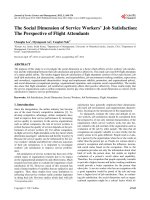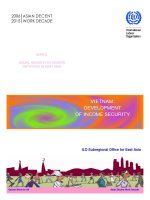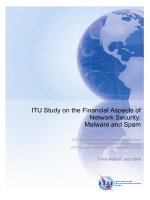The maritime Dimension of International Security docx
Bạn đang xem bản rút gọn của tài liệu. Xem và tải ngay bản đầy đủ của tài liệu tại đây (460.4 KB, 81 trang )
This document and trademark(s) contained herein are protected by law as indicated
in a notice appearing later in this work. This electronic representation of RAND
intellectual property is provided for non-commercial use only. Unauthorized
posting of RAND PDFs to a non-RAND Web site is prohibited. RAND PDFs are
protected under copyright law. Permission is required from RAND to reproduce,
or reuse in another form, any of our research documents for commercial use. For
information on reprint and linking permissions, please see RAND Permissions.
Limited Electronic Distribution Rights
Visit RAND at www.rand.org
Explore RAND Project Air Force
View document details
For More Information
This PDF document was made available
from www.rand.org as a public service of
the RAND Corporation.
6
Jump down to document
THE ARTS
CHILD POLICY
CIVIL JUSTICE
EDUCATION
ENERGY AND ENVIRONMENT
HEALTH AND HEALTH CARE
INTERNATIONAL AFFAIRS
NATIONAL SECURITY
POPULATION AND AGING
PUBLIC SAFETY
SCIENCE AND TECHNOLOGY
SUBSTANCE ABUSE
TERRORISM AND
HOMELAND SECURITY
TRANSPORTATION AND
INFRASTRUCTURE
WORKFORCE AND WORKPLACE
The RAND Corporation is a nonprofit
research organization providing
objective analysis and effective
solutions that address the challenges
facing the public and private sectors
around the world.
Purchase this document
Browse Books & Publications
Make a charitable contribution
Support RAND
This product is part of the RAND Corporation monograph series.
RAND monographs present major research findings that address the
challenges facing the public and private sectors. All RAND mono-
graphs undergo rigorous peer review to ensure high standards for
research quality and objectivity.
Peter Chalk
Prepared for the United States Air Force
Approved for public release; distribution unlimited
PROJECT AIR FORCE
The Maritime
Dimension of
International Security
Terrorism, Piracy, and Challenges
for the United States
The RAND Corporation is a nonprofit research organization providing
objective analysis and effective solutions that address the challenges
facing the public and private sectors around the world. RAND’s
publications do not necessarily reflect the opinions of its research clients
and sponsors.
R
®
is a registered trademark.
© Copyright 2008 RAND Corporation
All rights reserved. No part of this book may be reproduced in any
form by any electronic or mechanical means (including photocopying,
recording, or information storage and retrieval) without permission in
writing from RAND.
Published 2008 by the RAND Corporation
1776 Main Street, P.O. Box 2138, Santa Monica, CA 90407-2138
1200 South Hayes Street, Arlington, VA 22202-5050
4570 Fifth Avenue, Suite 600, Pittsburgh, PA 15213-2665
RAND URL:
To order RAND documents or to obtain additional information, contact
Distribution Services: Telephone: (310) 451-7002;
Fax: (310) 451-6915; Email:
The research described in this report was sponsored by the United States
Air Force under Contract FA7014-06-C-0001. Further information may
be obtained from the Strategic Planning Division, Directorate of Plans,
Hq USAF.
Library of Congress Cataloging-in-Publication Data
Chalk, Peter.
The maritime dimension of international security : terrorism, piracy, and
challenges for the United States / Peter Chalk.
p. cm.
“The research presented here was sponsored within RAND’s Project AirForce
(PAF) Strategy and Doctrine Program, as part of a wider effort exploring new
concepts for joint U.S. air-naval operations”—Pref.
Includes bibliographical references.
ISBN 978-0-8330-4299-6 (pbk. : alk. paper)
1. Merchant marine—Security measures—United States. 2. Security,
International. 3. Shipping—Security measures. 4. Maritime terrorism—Prevention.
5. Terrorism—Prevention. 6. Piracy—Prevention. 7. Unified operations (Military
science)—United States. I. Title.
VK203.C48 2008
359'.030973—dc22
2008014133
iii
Preface
In today’s global environment, transnational security challenges—
so-called grey-area phenomena—pose serious and dynamic challenges
to national and international stability. ese dangers, which cannot
be readily defeated by the traditional defenses that states have erected
to protect both their territories and populaces, reflect the remarkable
fluidity that currently characterizes world politics—a setting in which
it is no longer apparent exactly who can do what to whom with what
means. e maritime realm is especially conducive to these types of
threat contingencies given its vast, largely unregulated, and opaque
nature. Two specific issues that have elicited particular attention are
piracy and seaborne terrorism. is monograph assesses the nature,
scope, and dimensions of these two manifestations of nonstate violence
at sea, the extent to which they are or are not interrelated, and their
overall relevance to U.S. national and international security interests.
e research presented here was sponsored within the RAND
Project AIR FORCE (PAF) Strategy and Doctrine Program as a part
of a fiscal year 2006 study, “Exploring New Concepts for Joint Air-
Naval Operations.” e monograph draws heavily on interviews with
maritime experts and intelligence and security analysts who, given the
sensitivity of the subject matter, requested that their comments and
insights be used on a not-for-attribution basis. Names and affiliated
organizations of these individuals have therefore been omitted from
the text.
iv The Maritime Dimension of International Security
RAND Project AIR FORCE
RAND Project AIR FORCE, a division of the RAND Corporation, is
the U.S. Air Force’s federally funded research and development center
for studies and analyses. PAF provides the Air Force with independent
analyses of policy alternatives affecting the development, employment,
combat readiness, and support of current and future aerospace forces.
Research is conducted in four programs: Aerospace Force Develop-
ment; Manpower, Personnel, and Training; Resource Management;
and Strategy and Doctrine.
Additional information about PAF is available on our Web site:
/>v
Contents
Preface iii
Figures
vii
Tables
ix
Summary
xi
Acknowledgments
xvii
Abbreviations
xix
CHAPTER ONE
Introduction 1
CHAPTER TWO
Piracy 5
Scope and Dimensions
5
Factors Accounting for the Emergence of Piracy in the
Contemporary Era
10
e Dangers of Piracy
14
CHAPTER THREE
Maritime Terrorism 19
CHAPTER FOUR
A Piracy–Terrorism Nexus? 31
vi The Maritime Dimension of International Security
CHAPTER FIV
E
Relevance to the United States 35
reat Priorities
36
Principal Security Initiatives Spearheaded by the United States
38
CHAPTER SIX
Policy Recommendations 43
APPENDIX
Selected High-Profile Maritime Terrorist Incidents, 1961–2004 47
References
53
vii
Figures
2.1. Actual and Attempted Acts of Piracy, 1994–2006 8
2.2. Pirate Incident Locations, 2006
10
ix
Tables
2.1. Types of Violence to Crew and Passengers, 1995–2006 9
A.1. Selected High-Profile Maritime Terrorist Incidents,
1961–2004
48
xi
Summary
Maritime Piracy
Scope and Dimensions
A total of 2,463 actual or attempted acts of piracy were registered
around the world between 2000 and the end of 2006. is represents
an annual average incident rate of 352, a substantial increase over the
mean of 209 recorded for the period of 1994–1999.
e concentration of pirate attacks continues to be greatest in
Southeast Asia, especially in the waters around the Indonesian archi-
pelago (including stretches of the Malacca Straits that fall under the
territorial jurisdiction of the Jakarta government), which accounted for
roughly 25 percent of all global incidents during 2006.
Factors Accounting for the Emergence of Piracy in the
Contemporary Era
Seven main factors have contributed to the general emergence of
piracy in the contemporary era. First and most fundamentally, there
has been a massive increase in commercial maritime traffic. Combined
with the large number of ports around the world, this growth has pro-
vided pirates with an almost limitless range of tempting, high-payoff
targets.
Second is the higher incidence of seaborne commercial traffic that
passes through narrow and congested maritime chokepoints. ese
bottlenecks require ships to significantly reduce speed to ensure safe
passage, which dramatically heightens their exposure to midsea inter-
ception and attack.
xii The Maritime Dimension of International Security
ird, and specifically relevant to Southeast Asia, has been the
lingering effects of the Asian financial crisis. Not only did this event
exert a stronger “pull factor” on piracy—with more people (including
members of the security forces) drawn to maritime and other crime—
it also deprived many littoral states of the necessary revenue to fund
effective monitoring regimes over their coastlines.
Fourth, the general difficulties associated with maritime surveil-
lance have been significantly heightened as a result of the events of Sep-
tember 11, 2001, and the concomitant pressure that has been exerted
on many governments to invest in expensive, land-based homeland
security initiatives.
Fifth, lax coastal and port-side security have played an important
role in enabling low-level piratical activity, especially harbor thefts of
goods from ships at anchor.
Sixth, corruption and emergent voids of judicial prerogative have
encouraged official complicity in high-level pirate rings, which has
impacted directly on the “phantom ship” phenomenon.
1
Seventh, the global proliferation of small arms has provided pirates
(as well as terrorists and other criminal elements) with an enhanced
means to operate on a more destructive and sophisticated level.
The Dangers of Piracy
e dangers associated with contemporary piracy are complex and
multifaceted. At the most basic level, attacks constitute a direct threat
to the lives and welfare of the citizens of a variety of flag states. Piracy
also has a direct economic impact in terms of fraud, stolen cargos, and
delayed trips, and could potentially undermine a maritime state’s trad-
ing ability.
Politically, piracy can play a pivotal role in undermining and
weakening regime legitimacy by encouraging corruption among
elected government officials. Finally, attacks have the potential to
trigger a major environmental disaster, particularly if they take place in
crowded sea-lanes traversed by heavily laden oil tankers.
1
e phantom ship phenomenon involves the outright hijacking of oceangoing vessels and
their reregistration under flags of convenience for the purposes of illicit trade.
Summary xiii
Terrorism
Over the past six years, there has been a modest yet highly discern-
ible spike in high-profile terrorist attacks and plots at sea. ese vari-
ous incidents have galvanized fears in the West that terrorists, espe-
cially militants connected with the international jihadist network, are
moving to decisively extend operational mandates beyond purely ter-
ritorially bounded theaters.
Five main factors explain the presumed shift in extremist focus to
water-based environments. First, many of the vulnerabilities that have
encouraged a higher rate of pirate attacks also apply to terrorism.
Second, the growth of commercial enterprises specializing in
maritime sports and equipment has arguably provided terrorists with a
readily accessible conduit through which to gain the necessary training
and resources for operating at sea.
ird, maritime attacks offer terrorists an alternate means of caus-
ing mass economic destabilization. Disrupting the mechanics of the
contemporary “just enough, just in time” cargo freight trading system
could potentially trigger vast and cascading fiscal effects, especially if
the operations of a major commercial port were curtailed.
Fourth, sea-based terrorism constitutes a further means of inflict-
ing mass coercive punishment on enemy audiences. Cruise ships and
passenger ferries are especially relevant in this regard because they
cater to large numbers of people who are confined in a single physical
space.
Finally, the expansive global container-shipping complex offers
terrorists a viable logistical conduit for facilitating the covert move-
ment of weapons and personnel in two critical respects. First, because
much of the maritime trading system is designed to be as accessible
and flexible as possible (to keep costs low and turnover high), there
is no strong incentive to enact a stringent (and disruptive) regime of
security measures. Second, the highly complex nature of the container-
ized supply chain, combined with the ineffectiveness of point-of-origin
inspections, creates a plethora of openings for terrorist infiltration by
providing extremists with numerous opportunities to “stuff” or other-
wise tamper with boxed crates.
xiv The Maritime Dimension of International Security
A Terrorism–Piracy Nexus?
Complicating the maritime threat picture is growing speculation that
a tactical nexus could emerge between piracy and terrorism. One of
the main concerns is that extremist groups will seek to overcome exist-
ing operational constraints in sea-based capabilities by working in con-
junction with or subcontracting out missions to maritime crime gangs
and syndicates.
e presumed convergence between maritime terrorism and
piracy remains highly questionable, however. To date, there has been
no credible evidence to support speculation about such a nexus emerg-
ing. Just as importantly, the objectives of the two actors remain entirely
distinct.
at said, the possibility of a possible conflation between piracy
and terrorism has informed the perceptions of governments, interna-
tional organizations, and major shipping interests around the world.
ere have been persistent reports of political extremists boarding ves-
sels in Southeast Asia in an apparent effort to learn how to pilot them
for a rerun of 9/11 at sea. Indeed, such a specter was a principal factor in
driving the Lloyd’s Joint War Council to briefly designate the Malacca
Straits as an area of enhanced risk in 2005.
Relevance to the United States
e United States has been at the forefront of several moves to upgrade
global maritime security over the last five years, including
the Container Security Initiative
the International Ship and Port Facility Security (ISPS) Code
the Proliferation Security Initiative (PSI)
the Customs-Trade Partnership Against Terrorism.
In addition to these measures, the United States has been instru-
mental in instituting regional maritime security initiatives and capacity
building in areas recognized as vital to U.S. counterterrorism strategy.
•
•
•
•
Summary xv
On the positive side, these initiatives have helped to lend a degree
of transparency to what has hitherto been a highly opaque theater. On
the negative side, these programs suffer from three critical shortfalls as
presently configured:
ey are limited in scope.
ey are largely directed at strengthening the security “wall”
around commercial seaborne traffic, paying scant attention to
contingencies that do not involve containerized cargo.
With particular reference to the ISPS Code, there is still no defin-
itive means of effectively auditing how well extant measures are
being implemented by participating states or, indeed, to gauge
their overall utility in terms of dock-side security.
Policy Recommendations
At the policy level, there are at least four major contributions that
the United States could make to better safeguard the global oceanic
environment, including the following: (1) helping to further expand
the nascent regime of post-9/11 maritime security; (2) informing the
parameters of bilateral and multilateral maritime security collabora-
tion by conducting regular and rigorous threat assessments; (3) assist-
ing with redefining mandates of existing multilateral security and
defense arrangements to allow them to play a more effective and inclu-
sive role in countering maritime (and other transnational) threats; and
(4) encouraging the commercial maritime industry to make greater use
of enabling communication and defensive technologies and accept a
greater degree of transparency in its corporate structures.
In more specific terms, U.S. funds and support could be usefully
directed at (1) boosting the coastal monitoring and interdiction capa-
bilities of states in areas of strategic maritime importance; (2) actively
supporting the International Maritime Bureau’s piracy reporting center
in Malaysia; (3) augmenting port security management; and (4) spon-
soring research into cost-effective initiatives for better securing ships
and oceanic freight.
•
•
•
xvii
Acknowledgments
e author would like to thank the two reviewers of this mono-
graph—Martin Murphy of the University of Reading, UK, and Wil-
liam Rosenau of the RAND Corporation—for sharing their insights,
probing for weaknesses, correcting errors, and helping to improve the
overall quality of the analysis. e author would also like to acknowl-
edge the numerous maritime experts and intelligence and security ana-
lysts who agreed to be interviewed for the study but who asked not to
be identified by name or affiliated organization. Finally, a special debt
of gratitude is owed to the editor, Erin-Elizabeth Johnson, for her thor-
ough review of the initial manuscript.
All omissions and errors are the sole responsibility of the author.
xix
Abbreviations
AER area of enhanced risk
AFC Asian financial crisis
ATTF Antiterrorism Task Force (Phillipines)
CBP Coast Guard and Border Protection
CSI Container Security Initiative
CTF-150 Combined Task Force-150
C-TPAT Customs-Trade Partnership Against Terrorism
DoD Department of Defense
FoC flag of convenience
GAO Government Accountability Office
GFS Global Fleet Station
GPS Global Positioning System
IDSS Institute of Defense and Strategic Studies
IMB International Maritime Bureau
ISPS International Ship and Port Facility Security
JI Jemaah Islamyya
JWC Joint War Council (Lloyd’s)
xx The Maritime Dimension of International Security
KFR kidnap for extortion
MTSA Maritime Transport Security Act
NUMAST National Union of Maritime Aviation and Shipping
Transport Officers
PIRA Provisional Irish Republican Army
PSI Proliferation Security Initiative
RPG rocket-propelled grenade
SLOC sea-lane of communication
UNCLOS United Nations Convention on the Law of the Sea
1
CHAPTER ONE
Introduction
With the collapse of the Soviet Union and the European communist
eastern bloc in 1991, it was confidently assumed that the international
system was on the threshold of an era of unprecedented peace and sta-
bility. Politicians, academics, and diplomats alike increasingly began to
forecast the imminent establishment of a new world order that would be
managed by liberal democratic institutions and would develop within
the context of an integrated global economy based on the principles of
the free market.
1
As this unprecedented interstate structure emerged
and took root, destabilizing threats to national and international secu-
rity were expected to decline commensurately.
However, the initial euphoria evoked by the end of the Cold War
has been systematically replaced by a growing sense that global stabil-
ity has not been achieved, and has in fact been decisively undermined
by transnational security challenges, or “gray-area” phenomena. ese
threats, which cannot be readily defeated by the traditional defenses
that states have erected to protect both their territories and populaces,
reflect the remarkable fluidity that currently characterizes international
politics—a setting in which it is no longer exactly apparent who can
do what to whom with what means. Moreover, it has become increas-
ingly apparent in the contemporary era that violence and the readiness
1
See, for example, e International Monetary Fund, World Economic Outlook, Washing-
ton, D.C., 1991, pp. 26–27.
2 The Maritime Dimension of International Security
to kill are being used by the weak to create identity, rather than simply
express it.
2
Stated more directly, the geopolitical landscape that presently
confronts the global community lacks the relative stability of the linear
Cold War division between East and West. Indeed, many of today’s
dangers are qualitatively different from classical security threats of
overt military aggression stemming from a clearly defined sovereign
source. Rather, security, conflict, and general threat definition have
become far more opaque, diffuse, and amorphous.
3
e maritime realm is particularly conducive to these types of
threat contingencies because of its vast and largely unregulated nature.
Covering 139,768,200 square miles,
4
most of this environment takes
the form of high seas that lie beyond the strict jurisdiction of any one
state, constituting an area that is, by definition, anarchic. ese “over
the horizon” oceans are fringed and linked by a complex lattice of ter-
ritorial waters, estuaries, and riverine systems. ese bodies of water
are often poorly monitored and, according to internationally recog-
nized jurisprudence, exist as entirely distinct and independent entities.
5
Combined, these various traits and practices have imbued the planet’s
aquatic expanse with the type of unpredictable and lawless qualities
that omas Hobbes once famously wrote made life “nasty, brutish,
and short.”
Two specific threats that have been particularly highlighted are
piracy and maritime terrorism. is monograph assesses the nature,
scope, and dimensions of these two manifestations of armed violence
at sea, the extent to which they are or are not interrelated, and their
overall relevance to U.S. national and international security interests.
2
“Terrorism and the Warfare of the Weak,” e Guardian, October 27, 1993.
3
Peter Chalk, Non-Military Security and Global Order: e Impact of Extremism, Violence
and Chaos on National and International Security, London: Macmillan, 2000, pp. 1–2.
4
is equates to approximately 2.42 times the planet’s terrestrial surface area.
5
Rupert Herbert-Burns, “Terrorism in the Early 21st Century Maritime Domain,” in
Joshua Ho and Catherine Zara Raymond, eds., e Best of Times, the Worst of Times: Mari-
time Security in the Asia-Pacific, Singapore: World Scientific Publishing, 2005, p. 157.
Introduction 3
For the purposes of the analysis, the following two definitions will be
used:
Piracy is an act of boarding or attempting to board any ship with
the apparent intent to commit theft or any other crime and with
the apparent intent or capability to use force in furtherance of
that act.
6
Maritime terrorism refers to the undertaking of terrorist acts
and activities (1) within the maritime environment, (2) using or
against vessels or fixed platforms at sea or in port, or against any
one of their passengers or personnel, (3) against coastal facili-
ties or settlements, including tourist resorts, port areas and port
towns or cities.
7
6
is definition is the one used by the International Maritime Bureau (IMB). It is wider
than the conceptualization adopted under the 1982 United Nations Convention on the Law
of the Sea (UNCLOS), which restricts its focus only to attacks that take place on the high
seas (which is problematic, because the majority of piratical incidents occur in territorial
or coastal waters). e IMB definition also abolishes the traditional two-ship requirement,
meaning that attacks from a raft or even the dockside would be counted as an act of piracy.
See, for instance, Derek Johnson, Erika Pladdet, and Mark Valencia, “Research on Southeast
Asian Piracy,” in Derek Johnson and Mark Valencia, eds., Piracy in Southeast Asia, Singa-
pore: Institute of Southeast Asian Studies, 2005, pp. xi–xii. Also see Commercial Crime
Services, “International Maritime Bureau—Overview,” Web page, 2007.
7
is definition is used by the Council for Security Cooperation in the Asia Pacific Work-
ing Group on Maritime Terrorism. Although relatively broad, it captures the essential quali-
ties of the phenomenon in question. See Graham Ong, “Ships Can Be Dangerous Too: Cou-
pling Piracy and Terrorism in Southeast Asia’s Maritime Security Framework,” in Johnson
and Valencia (2005), pp. 61–62; Sophia Quentin, “Shipping Activities: Targets of Maritime
Terrorism,” MIRMAL, Vol. 2, January 20, 2003; and Metaparti Prakash, “Maritime Terror-
ism: reats to Port and Container Security and Scope for Regional Co-operation,” paper
presented at the 12th Meeting of the Council for Security Cooperation in the Asia Pacific
Working Group on Maritime Co-operation, Singapore, December 10–11, 2002, p. 1.









